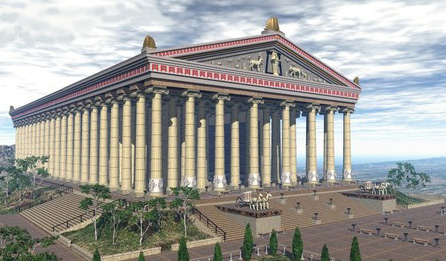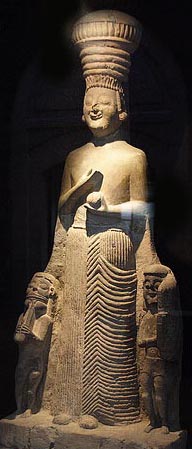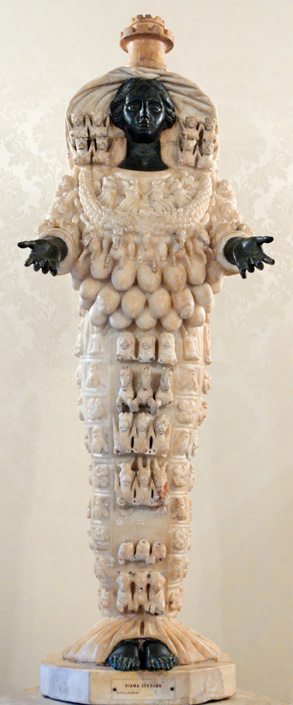Upis, Great Goddess of Lydia,
better known as Artemis Ephesia
Her temple at Ephesos in western Asia Minor was one of the Seven Wonders of the ancient Mediterranean, with a colossal statue of the goddess some 40 feet high and 127 columns, all 60 feet tall.

I have set eyes on the wall of lofty Babylon on which is a road for chariots, and the statue of Zeus by the Alpheus, and the hanging gardens, and the colossus of the Sun, and the huge labour of the high pyramids, and the vast tomb of Mausolus; but when I saw the house of Artemis that mounted to the clouds, those other marvels lost their brilliancy, and I said, "Lo, apart from Olympus, the Sun never looked on aught so grand".
--Antipater of Sidon [Greek Anthology IX.58]According to tradition, the Amazons built the first temple at this place. The oldest layers go back to at least the 8th century, and the shrine would have been much earlier. Construction of the monumental version started circa 550 BC and took over a century to complete. The temple originally stood on the coast but now its ruins lie miles inland, with only one column still standing.
Smiling Phrygian statue of Kybele, Great Goddess of the Mountain and the Animlas, Mother of the Gods. She is flanked by two musicians. Unfortunately her breasts have been destroyed.

A Roman-era copy of the original statue of Artemis Ephesia, destroyed in 401 when John Chrystostom led a mob and attacked the temple. The multiple breasts have also been described as eggs or fruits, especially figs (compare the crescent of grapes above it). Gerard Seiterle's theory that they were sacrificed bull testicles became popular among those who wanted to contradict the obvious breast symbolism. They argue that bull testicles were sacrificed to the Anatolian goddess Kybele, whose castrati priests offered up their own. By the sixth century, Artemis had her own eunuch-priest, the megabysos.

However, in 1987 archaeologists excavated a cache of amber pendants, many in the same shape as the pectoral of Artemis Ephesia, in the spot where the early statue of the goddess stood in the 8th century temple. This find disproves the bull-testicle theory. The position of the pendants on the statue is consonant with the idea of multiple breasts, which various ancient authors show was current in their time. The symbolism is multivalent, however, as it also resembles garlands of fruits, and many of the amber pendants are carved in the shape of pomegranates. A flood wiped out this early stratum of the temple, preserving the pendants and a Syrian ivory plaque with the tree of life, but not the wooden xoanon of the goddess.
•••
Numerous statues survive of a Black Artemis , like this Roman copy of the original Ephesian goddess in the Musei Capitolini. Late copies also adopt the mural (city walls) crown popular in the Hellenistic period. It was originally an attribute of Syrian Tyche, goddess of Fortune.
(See the amber finds here.)

More Asiatic Pillar Goddesses >
